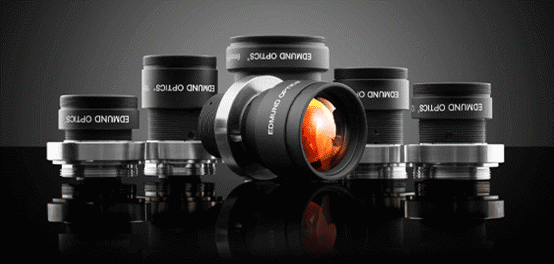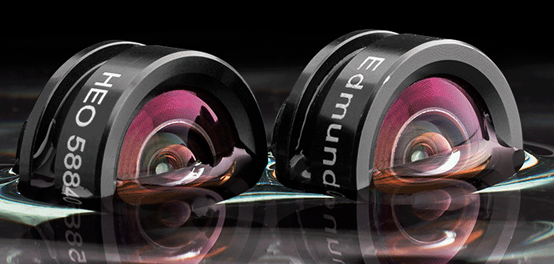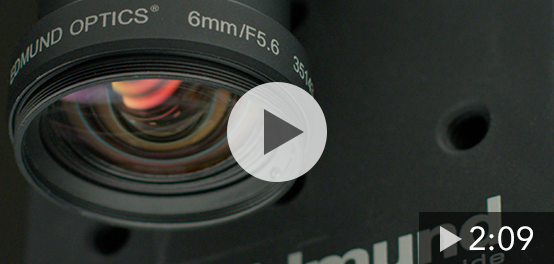成像鏡頭的強化設計
成像資源指南第5.3部份
在工廠自動化,機器人和工業檢測中使用的鏡頭必須能夠在特定和苛刻的環境中工作,可能涉及振動,衝擊,溫度變化和污染物。由於這些環境要求,新型的強化型鏡頭不斷被開發出來,用於不同的場景中。它們符合不同類型的強化設計。主要有四種不同的強化類型:
工業性強化
工業性強化鏡頭能夠適應振動和衝擊,避免鏡頭被損壞,保持鏡頭的焦距和f/#。為了實現這一點,我們取消了鏡頭的活動結構並使其更容易鎖止,不過這樣一來就犧牲了其靈活性。標准定焦鏡頭採用複雜的縮放光圈和調焦機制,典型的可縮放光圈由薄葉片和球形掣子組成,用於調節f/#,在衝擊和振動過程中可能會彈出。對於工業性強化鏡頭,可調光圈被移除,取而代之的是固定光圈。另外,在另一個螺紋筒內套用另一個螺紋筒的典型對焦結構被單螺紋和剛性 鎖定結構代替。


圖 1: A standard lens with complex mechanics and an adjustable iris vs. an industrial ruggedized lens with simplified mechanics.
工業性強化鏡頭非常適用於系統一旦建立好,就不再變動的應用。由於去除了複雜的移動和調整結構,將導致所需零件顯著減少,從而節省了成本,使得這類鏡頭擁有額外的成本優勢。很多應用都會用到工業性強化鏡頭,例如高振動的工廠環境,相機會進行快速加速和減速移動的情況,會反復進行多種相機安裝的檢測系統以及機器人視覺系統。
防護性強化
鏡頭前端入口處加固強化保護可讓鏡頭確保防潮和抵擋碎片。 這種加固強化始於工業加固強化技術(聚焦可調設計和可調光圈會有問題)。 在鏡頭前端使用保護元件包括 O 形密封圈和具疏水鍍膜的窗鏡確保符合 IPX7 和 IPX9K 規範讓鏡頭可在 1m 水深下操作30分鐘另外對於近距離,高壓和高溫熱流環境也可以適用。

圖 2:左邊帶有O型環的防護性強化鏡頭,可阻止污染物進入。右邊是一個穩定性強化鏡頭,所有鏡頭鏡片均採用膠合固定。
Ingress protection is specified with two digits, which make up the IP rating according to the IEC 60529 standard. The first digit describes the level of protection against solids and particles and ranges from zero to six. If a component has not been tested for protection against solid intrusion, the first digit is changed to an X (Table 1).
| Solid protection digit: | Description |
| X |
Testing for protection has not explicitly been conducted |
| 0 |
No protection from solid objects |
| 1 |
Protection from objects 50mm in diameter or greater |
| 2 |
Protection from objects 12.5mm in diameter or greater |
| 3 |
Protection from objects 2.5mm or greater |
| 4 | Protection from objects 1mm in size or greater |
| 5 | Partial protection from dust such that intrusion does not interfere with operation |
| 6 | Completely dust tight |
Table 1: The first digit of the IP rating describes the amount of protection an enclosure has from solids.
The second digit describes the protection from moisture and ranges from zero to nine (Table 2).
| Moisture protection digit: | Water Type | Description |
| X |
— |
Testing for protection has not explicitly been conducted |
| 0 | No protection from moisture | |
| 1 | Dripping | Protection from vertically falling droplets tested for 10 minutes |
| 2 | Protection from water droplets deflected up to 15° from vertical for 10 minutes | |
| 3 | Splashed or sprayed | Protection from water sprayed up to 60° from vertical |
| 4 | Protected from water splashes from all directions, tested for a minimum of 10 minutes | |
| 5 | Jet spray (pressurized) | Protection from low-pressure jets 6.3mm in diameter |
| 6 | Protection from direct pressure jets 12.5mm in diameter | |
| 7 | Continous Immersion | Protection from full immersion for up to 30 minutes at a depth between 15cm and 1m |
| 8 | Protection from extended immersion under higher pressure from depths greater than 1m | |
| 9 or 9K | High-pressure and-high temperature jet spray | Complete moisture protection from high-pressure, high-temperature jets, wash downs, and steam cleaning |
Table 2: The second digit of the IP rating describes the amount of protection an enclosure has from moisture.
Note that these ratings are not cumulative. Compliance with IPX7 or IPX8 does not guarantee IPX5 or IPX6 compliance. Products that comply with both a jet spray rating and a continuous immersion will be specified with both ratings. For example, the waterproof TECHSPEC® Cw Series Fixed Focal Length Lenses are IPX7 and IPX9K rated.
穩定性強化
與工業性強化鏡頭類似,穩定性強化可保護鏡頭免受損傷,同時還可確保在受到衝擊和振動後,其光學同軸性和定位仍可保持穩定。除了移除可調光圈並採用簡化的調焦結構外,各個鏡頭的內部零件都採用膠合固定,以防止他們在外殼中產生活動。圖 3 顯示了一個經過穩定性強化的鏡頭,鏡頭鏡片被膠合固定,並使用卡鎖來簡化對焦。

圖 3: Stability ruggedized lens with all lens elements glued in place.
鏡頭模組位於鏡筒的內孔內。鏡片的外徑和鏡筒的內徑之間的間隙很小(通常小於50微米)。儘管間隙十分狹小,不過幾十微米的偏心足以顯著影響鏡頭的同軸。在使用穩定性強化鏡頭時,如果物點位於視場的中心並準確的落在中心像素上,即使鏡頭被劇烈振動,它也將始終落在此處(圖5.8)。穩定性強化非常適用於必須進行視場校準的應用,例如測量設備,3D立體視覺,用於機器人感測的鏡頭,以及用於跟踪物體位置的鏡頭上。這些應用通常需要光學共軸始終保持穩定,變異量必須比單個像素小得多。


圖 4: 未擾動系統中物方紅色十字線映射到像方紅色十字準線,但帶擾動系統中因為鏡筒內鏡片產生位移導致藍色較差光學指向穩定性。
消熱差
Matter expands and contracts in response to temperature changes. The coefficient of thermal expansion (CTE) is a measure of how much a material changes in size. High-performance vision systems subjected to extreme or wide shifts in temperature require athermalized imaging lenses to minimize temperature-dependent performance changes. Athermalization refers to the process by which an optomechanical system is stabilized to extreme or changing temperatures, and also describes the optomechanical system that underwent the process. For more information on the optothermal and optomechanical effects of temperature on material expansion and the refractive index, read Thermal Properties of Optical Substrates.
通常消熱差鏡頭具有以下兩種設計方式:主動型或被動型消熱差設計。 主動型設計可能需要用戶在不同的溫度下進行性能調整,而被動型的特點是設計上可以針對溫度變化調整等不需要額外的調整機制。 Additional information about passive athermalization can be found in An Introduction to Passive Athermalization.













 上個章節
上個章節 


















or view regional numbers
QUOTE TOOL
enter stock numbers to begin
Copyright 2023, Edmund Optics Inc., 14F., No.83, Sec. 4, Wenxin Road, Beitun District , Taichung City 406, Taiwan (R.O.C.)
California Consumer Privacy Act (CCPA): Do Not Sell My Information